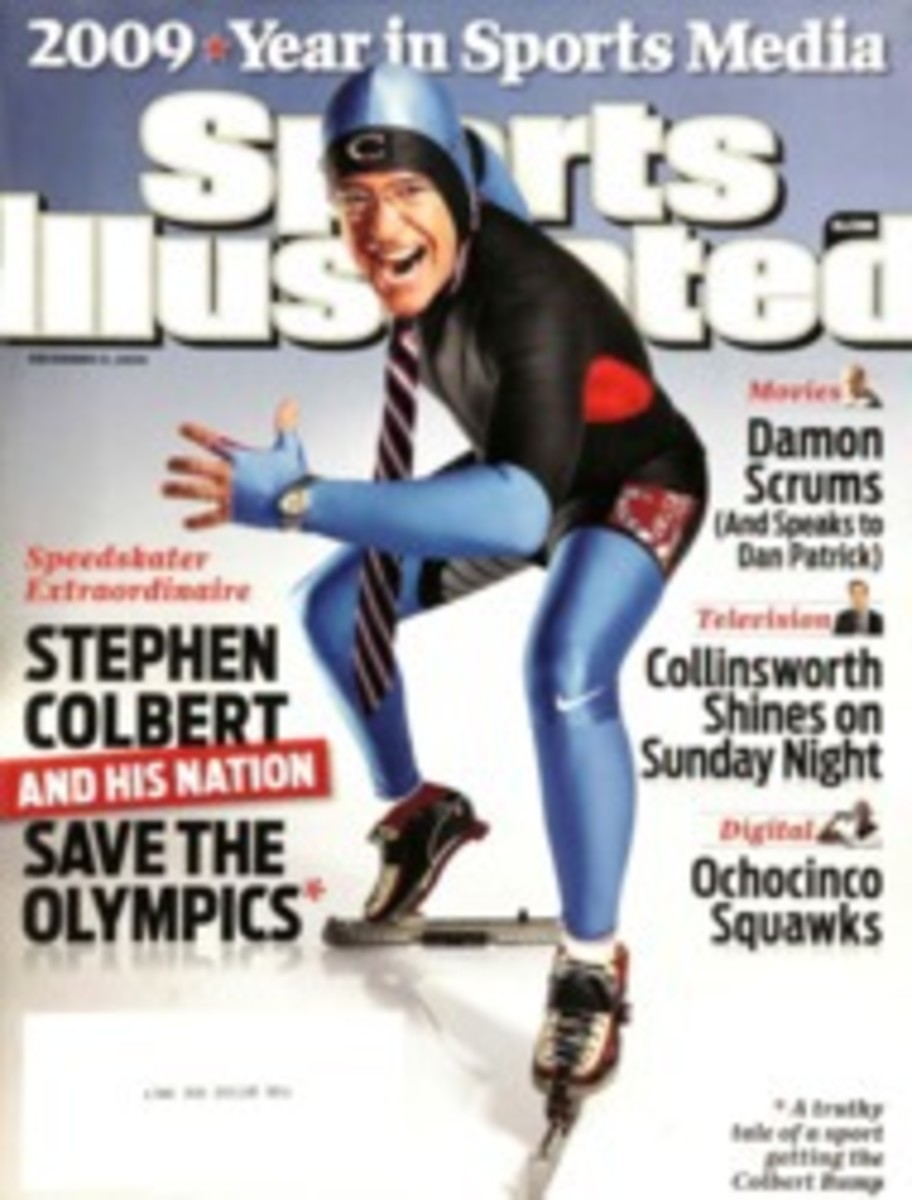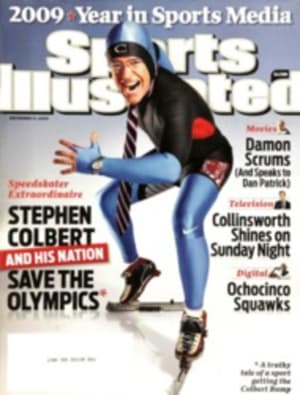
Basketball Jones
The New York Times nonfiction best-seller list is dominated by an eclectic albeit predictable cast of authors and personalities. There is usually a chicken-soup-for-the-soul type or two (hello, Mike Huckabee; welcome back, Mitch Albom); a purveyor of dirty laundry, especially one's own (Andre Agassi took what?); and a few political scream machines (now arm wrestling for space at the Borders coffee counter: the right reverend Glenn Beck and the Rouged Rogue!)
So what in the name of Naismith was a War and Peace--sized book (736 pages) about a culturally unpopular sport (pro basketball) written by a guy better known for being bookmarked than for being bookish (Bill Simmons) doing at the No. 1 spot a few weeks ago? And what was The Book of Basketball still doing at No. 14 on Sunday, hanging in there with What The Dog Saw by Malcolm Gladwell—who, by the way, wrote the foreword to Simmons's book?
"I always thought the book would sell," says Simmons, an ESPN.com columnist who has scaled literary heights despite going by the shot-and-a-beer sobriquet of The Sports Guy. But sell like this? And attract mainstream attention like no pro basketball book—excepting the occasional Charles Barkley I-was-misquoted-in-my-own-autobiography hit—since The Breaks of the Game, the 1981 classic written by one of Simmons's heroes, the late David Halberstam, who had won a Pulitzer Prize for his Vietnam reporting and written The Best and the Brightest before he took on pro hoops? "My NBA columns and mailbag columns were consistently the biggest draws of anything I wrote," Simmons says. "So I knew the audience was there for an NBA book as long as it was unique enough."
Unique it is. And that's true whether you celebrate Simmons as a revolutionary cultural force ("Perseverance and new perspectives break through. The old rots and washes away"—Will Leitch writing on Deadspin), or dismiss his influence ("[Simmons] is not a transformational figure. He did not reinvent sportswriting"—Charles Pierce, on the same website). There's a footnote or two on every page, something you don't see in the typical sports book. And Simmons's Hall of Fame Pyramid, in which he microanalyzes his alltime top 99 players, stretches 361 pages, about as long as it took Tolstoy to finally kill off Andrei Bolkonsky in the brutal Moscow winter.
The Sports Guy is not the first sports guy to wing his way into the rarefied air of the Times No. 1, but Simmons is the first to have established his literary bona fides primarily through what we in old media call new media. Reasonable readers may think Simmons's prose suffers from chronic gastritis after serving up oversized portions of pop culture—he is doubtless the only writer ever to name-check Keyser S√∂ze and The Usual Suspects during a discussion of the best single-season NBA teams. But there is much solid hoops analysis here, as when he lists six ideal point-guard qualities in breaking down the game of Nate (Tiny) Archibald (No. 60 in his pantheon). The last is worth quoting: "[D]efenders play four feet off you at all times because they don't want to have their ankles broken, which means you're starting the offense between the foul line and the top of the key on every possession."
And what can't be denied is that by writing two 4,000-word columns per week and now offering this 2,376-kilobyte challenge to Kindle, Simmons has disproved the notion that sports fans have limited attention spans. He even puts it in a Sports Guy kind of way. "[Sports fans] don't care about the length of a book, just that it's entertaining," Simmons says. "My book was designed in a way that you could read it in a week, in four months or even over the course of a year on the toilet bowl."
Soldier's Story
JON KRAKAUER, the best-selling author of Into Thin Air and Into the Wild, has always had an eye for individualists. So it's only natural that he would find his way to Pat Tillman's story, which he tells in Where Men Win Glory. In life Tillman, a former Cardinals safety, was a rare figure: principled, patriotic and selfless enough to give up an NFL career to enlist as an Army Ranger. In death—Tillman was killed by friendly fire in Afghanistan in 2004—he became something rarer still: a symbol easily adopted and celebrated by hawks and doves, patriots and subversives. But Krakauer dispenses with symbolism and, drawing on his subject's private journals, concentrates on Tillman the man. The result is a detailed portrait of a multifaceted figure—complicated, yes, but unquestionably a hero.
From SI
Several books were published by SI Books or written by SI writers and editors this year. The lineup includes:
1)The Golf Book, by SPORTS ILLUSTRATED;
2)The Yankee Years, by Joe Torre and Tom Verducci;
3)Strokes of Genius, by L. Jon Wertheim;
4)The First Star, by Lars Anderson;
5)When March Went Mad, by Seth Davis;
6)The Art of a Beautiful Game, by Chris Ballard;
7)The Machine, by Joe Posnanski;
8)A-Rod, by Selena Roberts;
9)Heart of the Game, by S.L. Price;
10)Monday Morning Quarterback, by Peter King;
11)The Beckham Experiment, by Grant Wahl;
12)The Football Book: Expanded Edition, by SPORTS ILLUSTRATED;
13)Swimsuit Portfolio: The Explorers Edition, by SPORTS ILLUSTRATED;
14)Slide Show, by SPORTS ILLUSTRATED;
15)Wow! The Pop-up Book of Sports, by SPORTS ILLUSTRATED KIDS
The Most ...
HIGH-POWERED PAIRING
LeBron. Buzz. The mononymous stars in their respective fields—basketball's James, sports books' Bissinger—teamed up on Shooting Stars, a memoir of the Cavaliers' star's youth in Akron. There aren't many jarring revelations, but it's an entertaining, well-written reminder that even if he seems to have been around forever, James (right) didn't go directly from the nursery to the NBA.
SOUL-BARING MEMOIR
If Andre Agassi didn't reveal all his secrets in Open, we shudder to think what he's holding back. The tennis great (with help from cowriter J.R. Moehringer) fesses up about using crystal meth, hating his sport, and worrying during matches that his hairpiece would come unmoored. Celebrity tell-alls are a dime a dozen, but Agassi is the king of the open era.
SOLE-SCRAPING NARRATIVE
In Born to Run, Christopher McDougall shines a light on the Tarahumara Indians, an isolated tribe in the canyons of northern Mexico. The Tarahumara live primitively and have an innate ability to run ultramarathon distances effortlessly—in bare feet. The portrait of the tribe is entertaining and respectful; the book (the third-best-selling sports title according to Nielsen Bookscan) was the surprise hit of the year.
READABLE CONGRESSIONAL TOME
The coffee-table volume Baseball Americana mines the Library of Congress's archives for photos, posters, essays, old ads, sheet music and scores of other pop culture artifacts connected to the national pastime. It's a sharp look at how baseball mirrors American culture and vice versa—and far more fun to flip through than a health-care bill.
WELCOME REISSUE
In 2008 Once a Runner, John L. Parker Jr.'s self-published, out-of-print 1978 novel about an obsessed college miler, was the most-searched title on Bookfinder.com. So Scribner did the sensible thing in '09, rereleasing what Runner's World called "the best novel ever written about running." Three decades later the book still has an impressive kick.
INSIGHTFUL HALL OF FAMERS
In Jackie MacMullan's When the Game Was Ours, Larry Bird and Magic Johnson reflect with wit and wisdom on their rivalry, friendship and the state of the NBA. Sixty Feet, Six Inches is more conversational, a spirited back-and-forth between Reggie Jackson and Bob Gibson, weighing in on a wide range of baseball topics (hitting, pitching, steroids and more) and telling some terrific tales. Eavesdropping on icons has never been more fun.
The Brow Beat
HIGH
SUGAR RAY ROBINSON was a great fighter—that's not news. But in the excellent bio Sweet Thunder, Wil Haygood argues that Robinson was a mid-century cultural icon on par with Langston Hughes and Miles Davis. It's a literary knockout.
LOW
WANT TO FEEL like an MMA fighter? Slam your head with a brick—or read UFC star Forrest Griffin's profane Got Fight? The 50 Zen Principles of Hand-to-Face Combat. Like MMA, it's not for the faint of heart.
PHOTO
ROBERT BECK (SIMMONS)
PAGE VIEWS Simmons's hoops analysis and fan-boy rants resonate as sharply in print as they do in pixels.
PHOTO
ISAAC BREKKEN/AP (GRIFFIN)
PHOTO
ARIZONA CARDINALS/AP (TILLMAN)
PHOTO
GREG NELSON (JAMES)
PHOTO
COURTESY OF PRINTS & PHOTOGRAPHS DIVISION, LIBRARY OF CONGRESS (BASEBALL AMERICANA)
EIGHTEEN PHOTOS

